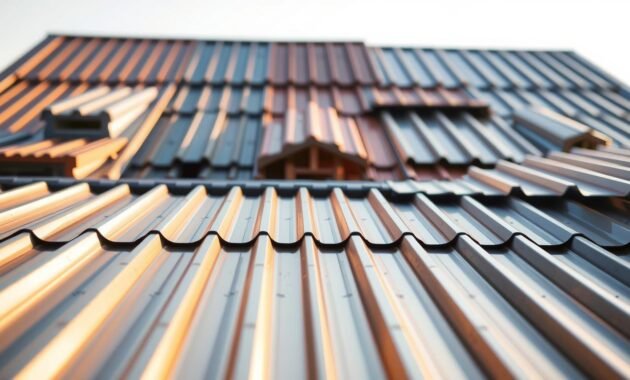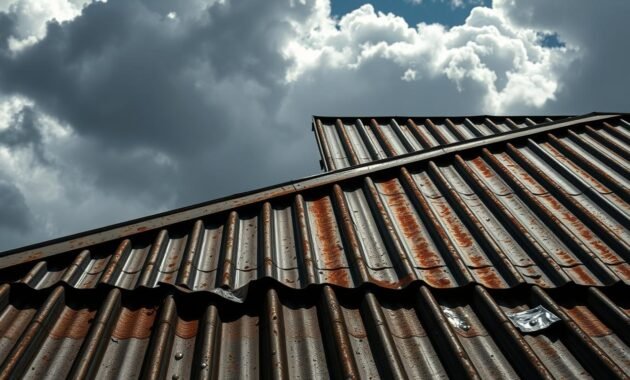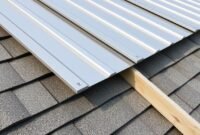Are you dealing with water pooling and leaks on your metal roof? Many homeowners struggle with the wrong roof pitch. This can turn your dream roof into a costly headache.
Knowing the roof pitch requirements is key to protecting your home. Different roofs need specific slopes for good water drainage and durability. I’ll share the essential tips for installing a metal roof slope to avoid water problems and improve your roof’s performance.
This guide will cover everything about metal roof minimum slope. You’ll learn about basic measurements and climate-specific needs. Get ready to become an expert in roof pitch requirements and protect your home’s most important barrier.
Understanding Metal Roof Slope Basics
Roof slope is key to a metal roof’s performance, yet many homeowners miss it. When I work on metal roof projects, I stress the need to know about slope. It affects how well the roof works.
What is Roof Slope Measurement
Roof slope is how steep the roof is, shown as a ratio. For metal roofs, this is vital for water flow and roof health. Experts figure it out by measuring the roof’s rise over 12 inches of horizontal space.
Common Slope Ratios Explained
- Low slope roofs: 2:12 to 4:12 pitch
- Medium slope roofs: 4:12 to 9:12 pitch
- Steep slope roofs: 9:12 pitch and above
Impact on Roof Performance
The right slope for metal roofs is key for water flow and roof life. A good slope means:
- Water runs off well
- Less chance of leaks
- Better wind protection
| Roof Type | Minimum Recommended Slope | Key Characteristics |
|---|---|---|
| Standing Seam Metal Roofs | 1/4:12 | Highest water resistance |
| Corrugated Metal Panels | 3:12 | Good for moderate climates |
| Metal Shingles | 3:12 | Versatile installation options |
Knowing about roof slope helps you choose the best for your home. It ensures your roof works well and protects your home.
The Importance of Proper Roof Drainage
Proper drainage is key to keeping metal roofs in top shape. It helps avoid expensive repairs and makes your roof last longer. Knowing how to manage water is a must for metal roofing standards.
Low-slope roofs face special challenges with water. The roof’s slope affects how well it sheds water. This is important to stop problems like:
- Water pooling
- Rust formation
- Structural damage
- Potential leaks
Even a small change in roof slope can make a big difference. Most metal roofs need a certain slope to drain water well. Standing seam roofs should have a slope of 1/4 inch per foot. Corrugated panels need a steeper pitch of 3 inches per foot.
The weather also matters for roof slope. In places with lots of snow or rain, a steeper roof helps avoid water buildup. The right slope can:
- Improve water shedding
- Minimize leak points
- Reduce material wear
- Make your roof last longer
Getting your roof installed by pros is essential. They know local codes and can suggest the best slope for your roof.
Metal Roof Types and Their Slope Requirements
Choosing the right metal roofing means knowing about slope needs and how well they perform. Each metal roof style has its own set of rules that affect how long it lasts and how it’s put up.

Metal roofing comes in many styles to fit different building needs. I’ll explain the most common types and what slope they need.
Standing Seam Metal Roofing
Standing seam roofing is a top choice for its great water-shedding ability. It has raised seams that run up and down, giving it a clean, modern look. The slope needed is between 1/4:12 and 2:12, based on the panel design.
- Minimum pitch: 0.25:12 for advanced panel systems
- Maximum recommended pitch: Up to 12:12
- Ideal for both residential and commercial applications
Corrugated Metal Panels
Corrugated metal roofs have different slope needs than standing seam ones. They have wavy patterns that help water flow and add strength. They usually need a slope of at least 1/2:12, fitting many building styles.
| Panel Type | Minimum Slope | Water Resistance |
|---|---|---|
| R Panels | 1:12 | Good |
| 7.2 Panels | 1:12 to 2:12 | Moderate |
Metal Shingles and Tiles
Metal shingles and tiles look like traditional roofs but are made of metal. They need steeper slopes, from 3:12 to 6:12, to keep water from leaking.
Knowing these slope needs helps pick the best metal roofing for any project.
Minimum Slope Requirements for Different Climates
Choosing the right metal roof slope is key for good performance in different climates. Each area has its own challenges that affect roof design. This is true for both homes and businesses.
Weather greatly affects the best metal roof slope. Let’s look at how different weather patterns influence slope choice:
- Tropical Regions: Need steeper slopes for intense rainfall drainage
- Snowy Areas: Require higher pitch to prevent snow accumulation
- Arid Climates: Can accommodate lower slope configurations
- Coastal Zones: Demand robust slope designs to handle wind-driven rain
Here’s a detailed look at slope needs for different climates:
| Climate Type | Recommended Minimum Slope | Key Considerations |
|---|---|---|
| Heavy Rainfall Areas | 1/2:12 | Ensures quick water runoff |
| Snowfall Regions | 3:12 | Prevents snow buildup |
| Moderate Climate | 1/4:12 | Standard drainage capabilities |
I suggest talking to local roofing experts who know your area’s weather. They can give advice on commercial roofing slope needs for your exact weather conditions.
Common Issues with Low-Slope Metal Roofs

Low-slope roofs face special challenges that can affect their durability. When the roof is too flat, water can’t drain well. Roofs with slopes under 3:12 often struggle to shed water, leading to problems.
The main issues with low-slope metal roofs are:
- Water Ponding: Water doesn’t drain fast, causing it to pool on the roof
- Increased Risk of Leaks: Water on the roof can damage the drainage system
- Accelerated Material Degradation: Moisture makes the roof materials wear out faster
- Debris Accumulation: Flat roofs catch leaves, branches, and other debris
It’s important to think about your roofing needs carefully. Low-slope roofs need extra care to avoid damage. The wrong slope can turn a durable roof into a big maintenance problem.
| Roof Type | Minimum Recommended Slope | Potential Issues |
|---|---|---|
| Standing Seam Metal | 1/4:12 | Water retention, possible leaks |
| Corrugated Metal | 1/2:12 | Debris buildup, poor drainage |
| Metal Shingles | 4:12 | More maintenance needed |
Getting your roof installed by a pro and keeping it up is key. The right design, quality materials, and drainage solutions can help avoid problems. This way, your roof can last longer.
Factors Affecting Metal Roof Slope Selection
Choosing the right slope for a metal roof panel is complex. It’s not just about picking a number. It’s about matching the roof to the environment and structure.
Read also: The Guide on How to Insulate Under Metal Roof Panels
When picking a roof pitch, several important factors come into play. Let’s look at the key things that affect your metal roofing slope choice.
Local Weather Conditions
Weather is a big factor in choosing a roof slope. Different climates need different roofing solutions:
- Places with lots of snow need steeper roofs
- Areas with a lot of rain need roofs that drain well
- Wind can also affect how a roof performs
Building Design Considerations
The design of a building also affects the roof pitch. Complex roofs with many angles might need steeper slopes to keep water out.
| Roof Pitch | Recommended Usage | Drainage Efficiency |
|---|---|---|
| Low Pitch (2:12 – 4:12) | Commercial Buildings | Limited |
| Moderate Pitch (4:12 – 9:12) | Residential Homes | Good |
| Steep Pitch (9:12 and above) | Traditional Architecture | Excellent |
Material Compatibility
Different metal roof panels need specific slopes. Some materials work better at certain pitches. This makes choosing the right material important for a roof that lasts.
Knowing these factors helps you pick the best slope for your roof. It’s about finding a balance between looks and function.
Installation Best Practices for Optimal Slope
Installing a metal roof needs precision and careful attention to slope. As a roofing expert, I’ve found that proper installation is key. It ensures the roof works well and lasts long.
When thinking about installation slope tips, several important factors come up. The minimum slope needed depends on the metal roofing type:
- Standing seam metal roofs: Minimum 1/4:12 slope
- Corrugated metal panels: Minimum 3:12 slope
- Metal shingles and tiles: Minimum 3:12 slope
Metal roofing standards require careful attention to several key practices:
- Make sure panels overlap right to stop water from getting in
- Use the right fasteners with rubber grommets for watertight seals
- Choose the right underlayment for your roof slope
- Install proper flashing around roof penetrations
| Roof Type | Minimum Recommended Slope | Key Installation Considerations |
|---|---|---|
| Standing Seam | 1/4:12 | Mechanical seaming, precise panel alignment |
| Corrugated Panels | 3:12 | Additional sealants, overlapping techniques |
| Metal Shingles | 3:12 | Proper interlocking, edge sealing |
Local building codes and climate conditions are also key. Always talk to a pro to make sure your metal roof meets all standards.
Conclusion
Knowing about metal roof minimum slope is key for a strong roof. This guide has covered the important details of metal roofing standards. These standards help protect your home from water damage and ensure it works well.
It’s important to manage the slope of metal roofing carefully. Most metal roofs need a slope of at least 3:12. This slope helps water drain off and prevents moisture buildup. Your roof’s design and local weather can affect the slope needed for the best protection.
Read also: Screw Pattern for Metal Roofing
It’s wise to hire skilled roofing contractors. They know about local weather and can meet your roof’s specific needs. The right slope for your metal roof will make it last longer and work better.
Choosing the right slope for your metal roof is a smart investment. It can save you money on energy and reduce maintenance costs over time. Every degree of slope is important for a roof that lasts and performs well.




